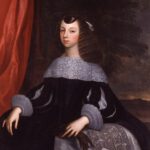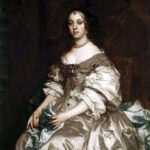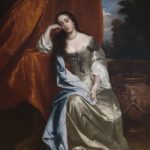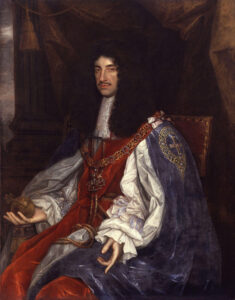Charles II.
The Merry Monarch
*05/1630
†02/1685
Parents
Father: Charles I.
Mother: Henriette Marie de Bourbon
Marriage
Katharina Henrietta of Braganza
Children
17 illegitimate from Mistresses
Coronation
01/1651 in Scone (for Scotland)
04/1661 in Westminster Abbey (for England)
Regency
05/1660 to 1685
By the Death of his older Brother shortly after birth, Charles was the Heir to the Throne.
His Mother, however, was not very enthusiastic about him and was ashamed to show him. In a Letter she is supposed to have written:
“[…] he is so ugly I am ashamed […] but his size and fatness supply what he lacks in beauty.”
From 1631 he and his Brother James were under the Care of Educators and were introduced by their Father Charles I. early in the national business. According to tradition, one day after Charles I. had the War Banner hoisted in 1642 – when they were hiding in a Barn in front of parliamentary Troops – it came to an incident that showed the Courage of the young prince…
Detected by the Troops, Charles pulled a Gun, aimed at the Men and said “I fear them not”. When royal Troops stormed the Barn, Charles and his Brother were released from the situation.

Although never formally awarded because of the Civil War, he led the Titel Prince of Wales and had from 1643/44 his own advisory staff, consisting of Edward Hyde, Sir Arthur Capel, Baron Ralph Hopton and selected royalists.

As early as 1644 Charles` Mother forged Marriage Plans with Luise Henriette of Oranien, but their Father, Frederick Henry of Oranien, refused. The Plans to marry him to Johanna, second Daughter of King John IV. of Portugal, or to the Daughter of Jean-Baptiste Gaston, Duke of Orléans, Anne Marie Louise d’Orléans, also dashed. Finally, Charles later married Catherine Henrietta of Braganza, the younger Sister of Johanna of Portugal.
In March 1646 Charles followed his Mother into Exile and landed with his Staff in St. Mary on the Isles of Scilly.
The King, Charles I., knew nothing about the Escape. Although the Parliament asked him to come back in a formal Letter, but Charles declined friendly, but determined. A month later, he traveled -after his Father had asked him in a Letter- to the Island Jersey at the end of the Summer to his Mother and Sister to France. It was only in August that Charles and his Family were officially invited to the french Court of King Louis XIV., who secured his Livelihood, where they only considered themselves silent, as Charles barely spoke a single word of French.
When Charles` Mother Henrietta decided to send him to Calais to intervene more quickly in the development of England, this was prevented by Cardinal Mazarin, the governing Minister of France. He indicated that Charles should not leave France. Only when Riots and Civil War broke out in France, was the “House Arrest” lifted. The original Plans to travel directly to Scotland were thwarted and Charles went to Den Haag, where he met his younger Brother James. The Revolt of the english Fleet -his Plans to travel to Scotland was thwarted- turned out to be a Revolt of dissatisfied Sailors backed by James.
The plans were resumed and he reached with his Entourage in July 1648, the south-english Isle of Wight. After landing, Charles freed with his Troops the City Colchester, confiscated several Ships and built a blockade at the Thames Estuary. The following August, the Earl of Lauderdale tried to persuade Charles to travel to Scotland, but shortly before his Decision, scottish Troops were beaten by Cornwell and he returned to Den Haag.
In February 1649 Charles learned of the Death of his Father and was proclaimed King on Jersey.
“The occasion seems suitable for all Christian princes to come to the help of His Majesty, to avenge as befits, the dreadful and never-before-heard-of deed …”
Now Charles was proclaimed King in Edinburgh, too and if he gave written Assurance of Freedom of Belief, he was given the opportunity to ascend the scottish Throne.
In June 1650 he reached Scotland, signed the Declaration and was crowned King in Scone. However, his Fight against Cromwell failed in September 1651 at the Battle of Worcester and he had to hide in an old Oak, from where he disguised over the Normandy had to flee back to Den Haag into Exile. From there he traveled to the belgian Spa, where he was met his Sister Mary -the indebted Widow of William II. of Oranien- and their Son William III. In the following years he traveled with her to Aachen, Düsseldorf, Cologne, Frankfurt and Brussels, before setting up a permanent Household in Bruges, Belgium.
Although there were probably extravagant Orgies and he made numerous Affairs, the King without Kingdom was welcomed by the People. From there, he moved back to Den Haag in 1655. Although already finished, make him the life and the dealings of his lover Lucy Walter -Charles had an Affair with her during his first stay in 1648- obviously problems. She plunged into numerous Affairs until Charles became too much and asked his Friend and Confidant Theobald Taaffe to take her out of Den Haag.
“Advise her, both for her sake and mine, that she goes to some place other than Den Haag, for her stay there is very prejudicial to us both”
Back to the Monarchy
After the Death of Oliver Cromwell and the brief insignificant Succession of Richard Cromwell, Charles had legitimate Hope for the english Throne, for which he -by new elections predominantly royalist- the London Parliament in 1660 the royal Dignity.
Charles traveled to Dover and moved in May in an acclaimed Procession in London. Contrary to the promise of impunity, Charles let the Murderers -the lives, too- of his Father proceed. (see Oliver Cromwell)
Charles had only illegitimate Children with different Women.
To ensure Succession to the Throne, the Marriage to the Portuguese Princess Catherine of Braganza was arranged. Charles had to assure his new Wife the free Exercise of her Faith, guarantee full commercial and religious Freedom to all english Subjects in Portugal, and assure Portugal military Protection against Spain and France.
In April 1662 Catherine traveled with her Entourage to England, where she reached Portsmouth in May. When Charles saw his future Wife for the first time, he is said to have been confused by the portuguese Hair Fashion:
“My god, they sent me a bat instead of a woman.”
Also handed down the Request Catherine´s for a Cup of Tea, to which Charles replied …
“We don’t drink tea in England. But maybe some ale will do?”
At that time, tea was barely known in England!

Catherine also knew little about Court Life at the time of her marriage, as she was reared and grew up in a Monastery.
Nor did she know that her Husband had several illegitimate Children and was indulging in other Affairs. His main Mistress was Barbara Villiers, who later became Catherine´s Chambermaid.
She quickly learned english Humor and Expression. When Charles did not show up for Dinner because of an alleged Cold, she wanted to visit him. She discovered under the Bed the Foot, one of his Affairs and said:
“Ha, I will be off. I see it is not you who had the cold.”
In 1662 Charles sold the city of Dunkirk to his cousin Louis XIV and, in recognition, donated the north american Countries Carolina, named after his Father, to eight Nobles.
Although Katharina contradicts her political interest in the Catholics.
She blamed her for the plague epidemic of 1655 and the Great Mark of London in 1666. There also remained the marriage, which was seen as a sign of heaven. Charles’s younger brother James, Duke of York, was known as Catholicism, turning to James Scott from the affair with Lucy Walter. James Scott was unlawful, but Charles first-born and above all Protestant, since the English were the return of a Catholic king. The calls for Scott’s divorce and legitimacy grew louder. However, Charles refused as an absolutist ruler and the English Parliament did not want to play a precedent in deciding the private affairs of the king. His royal dignity was for him will and his cause to defend his will against the will of Parliament and people. War, war II was more relentless in the protection of his interests.
Although Catherine showed no political interest, they were accused -in favor of the Catholics- of putting pressure on the King.
They were even blamed for the Plague Epidemic of 1655 and the Great Fire of London in 1666 because of their beliefs. Since the Marriage remained childless, this was seen as a Sign of Heaven and the demand for a Divorce was loud. Heir to the Throne at this time would have been Charles` younger Brother, James, Duke of York, but when he became Catholic in 1672, they turned to James Scott – Charles` Son from the Affair with Lucy Walter. Although James Scott was illegitimate, but the first-born of Charles and above all Protestant, as the English rejected the return of a catholic King. The calls for Divorce and Scott’s legitimacy grew louder. Charles refused, because he felt like an absolutist Ruler and did not want to set a precedent in the hands of the english Parliament to decide on the private affairs of the King. His royal Dignity was God’s Will for him and at the same time his task was to defend that Will of God against the Will of Parliament and the People. Since his Father had been sentenced to Death by Parliament’s decision, Charles II. was all the more relentless in safeguarding his interests.
Questions of Faith
The Restriction of maritime Trade caused by Cromwell eventually led to the second War with the Netherlands in 1665. After a surprise attack by the Dutch on english Soil, the fighting was stopped and Peace was concluded. It even joined forces with Sweden against the Foreign Policy of Louis XIV. Later, however, this Alliance was destroyed by the ‘Treaty of Dover’. According to this Contract, which Charles concluded with Louis XIV., Charles would have received £ 200,000 annually if he supported his Cousin with Troops and publicly professed Catholicism at an appropriate time. He then secured 6000 Soldiers, but kept the Treaty secret.
To this day, it is not clear that he ever wanted to carry out this Conversion, since he remained Protestant until his Death.
In March 1672, Charles issued the “Declaration of Freedom of Conscience.”
In the Statement, he called for the repeal of the criminal Laws against churchly different Thinker (Dissenters). The Catholics were therefore allowed to hold services only in certain places with legally authorized Preachers and were allowed to perform private Worship again. In addition, almost 500 Dissenters were pardoned. After a year, the Statement was withdrawn by the Parliament and the Catholics excluded from all posts. Even Charles` Brother James had to resign from his post as Grand Admiral.
In 1678, Parliament even passed a Law prohibiting Catholics from sitting in Parliament’s Upper or Lower House.
By a “Catholic Hustle” spurred on by Titus Oates, Charles` Brother was excluded from succession to the Throne and his Wife Catherine accused of wanting to poison the King -whose Chambers were then searched. The King himself then interrogated Oates and had him -after Oates entangled in contradictions- imprisoned him. Parliament freed him again and he lived until 1681 as a free man, but repeatedly plotted on plots. Judge George Jeffreys (Hanging Judge Jeffreys) described Oates as a Shame to Humanity and sentenced him to a prison sentence.
Oates was supported by Duke of Leeds Thomas Osborne, who was charged in 1678 for treason. Without his interference, Oates’ accusations could never have reached levels that seriously affected Peace in the Country. Due to divergent opinion, Charles dissolved the Parliament in January 1679. Already in March, a new Parliament was set up, but this was hostile to the King and blocked his decisions.
In December 1679, the parliament was dissolved by Charles again.
The position of the english King was clear.
No temporal power had to intervene in the succession, in his view, by divine grace. Despite further attempts to reach an Agreement and an increase in statements of Loyalty, Parliament has been dissolved time and again. From 1681 Charles reigned as an absolutist Monarch without a Parliament.
In the Spring of 1683, a plot to kill the King and his Brother James was uncovered (Rye House Plot). The Plan was to kill both as they visited the Horse Races in Newmarket. However, a big fire that broke out shortly before in Newmarket prevented the visit of the royal Brothers and thwarted the murder plans. The protestant Politicians Algernon Sidney and Lord William Russell were accused of being the driving forces in the planning and charged with High Treason. Despite the thin Evidence, both were sentenced to Death.
Charles, who converted to the catholic Faith shortly before his Death, died unexpectedly and after a short illness from a urine poisoning, shortly after he received the Sacraments of the Dead through the Priest John Huddleston.
He was buried in Westminster Abbey.
Life Charles was filmed in ‘Charles II.: The Power and the Passion’ of 2003.
Charles II. | James VII. | Mary II. & William III. | Anne
